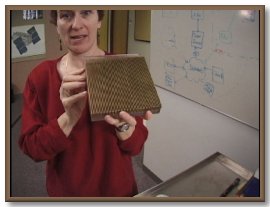|
|
|
The HETGS (High Energy Transmission Grating Spectrometer) one of two instruments on board Chandra dedicated to high resolution spectroscopy.
|
P2K:
What challenges do you have to face on a day-to-day basis to do your job well?
KF:
I think the biggest challenge that I encounter on a day-to-day basis is the constant reminder that I don't need to know everything before I start. The point of the exercise is to learn, and not to know. But it can be a little bit daunting. Not knowing what's going to happen, what you're going to find, what the answer is. Even discovering the question and not knowing if you'll ever find the answer can be a difficult problem. Anticipating potential problems with the Observatory can be a little bit stressful, but we have to take those as they arise.
P2K:
What at school or at home, or reading books, or seeing feature films got you started on this career?
KF:
I would have to say; I got started on this career probably before I was twelve. Basically, I think every person sits on a hill somewhere and looks at the stars and wonders what's out there, if there's anything looking back, or how we started, not just as a bunch of human beings, but how the Earth started, how the Universe started, how it's going to end. Your basic questions that you ask as a kid, and if you're smart enough, you continue to ask through life. I think those questions got me interested in science, and certainly pointed me toward astronomy.
Also I found that science is a common language of communication. One scientist will respect and understand another scientist, one person will respect and understand another person, they deal at the level of what they see as the truth.
|
|
|
Kathy demonstrating how the HETGS works.
|
P2K:
What is the type of question that you'd be happiest to have had some kind of hand in solving, the biggest astronomical mystery that's out there at the moment that you will be pleased to shed some light on?
KF:
I work with supernova remnants, and I would dearly love to understand one supernova remnant really well. I'm working on an object right now, and I'm beginning to have an idea of not only what its general shape is, but how it's moving, how old it is, what's happening to it, what shock fronts are moving through it, what it's made of, and where it came from. And I would love just to solve that question. I think that would be a wonderful step forward.
P2K:
What determines whether a star will end in a supernova or some other end state?
KF:
A star's mass determines nearly everything about its history. For stars that are not too massive, such as our Sun, their end state will not be quite the spectacular end that a supernova explosion is. But for a star more massive--let's say five, or eight solar masses and greater--such a star will inevitably, almost inevitably end in a supernova explosion. This is a fairly dramatic result in which the outer layer of material is cast off violently from the star in a huge explosion. In the case of a supernova remnant, which is what's left over hundreds to thousands of years afterwards, much of this material sweeps up the local material around it and makes a big shell of bright, hot material.
...Life on Earth actually owes a significant debt to supernovae and supernova remnants. It turns out that many elements are manufactured only during a supernova explosion. And most of our heavy elements, chemical elements such as oxygen, neon, iron, and others, are distributed by this supernova explosion and through the supernova remnant. The oxygen we breathe more than likely came from supernovae, and supernova remnants that existed prior to our arrival here. So, in fact, there is a deep link between these events and life on Earth and our solar system as we know it.

